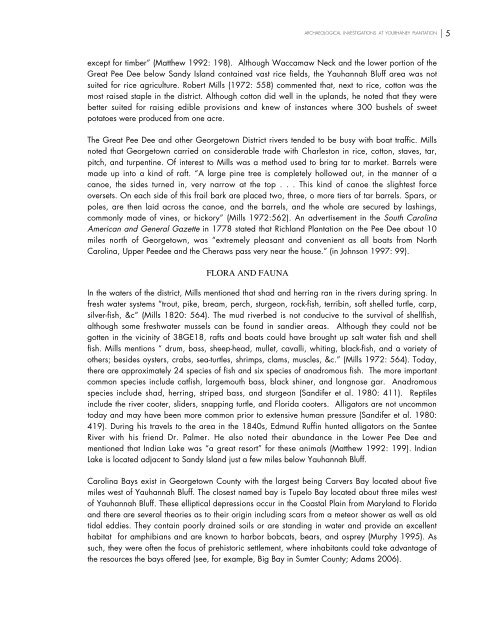Archaeological Investigations at Yourhaney Plantation (38GE18)
Archaeological Investigations at Yourhaney Plantation (38GE18)
Archaeological Investigations at Yourhaney Plantation (38GE18)
You also want an ePaper? Increase the reach of your titles
YUMPU automatically turns print PDFs into web optimized ePapers that Google loves.
ARCHAEOLOGICAL INVESTIGATIONS AT YOURHANEY PLANTATION5except for timber” (M<strong>at</strong>thew 1992: 198). Although Waccamaw Neck and the lower portion of theGre<strong>at</strong> Pee Dee below Sandy Island contained vast rice fields, the Yauhannah Bluff area was notsuited for rice agriculture. Robert Mills (1972: 558) commented th<strong>at</strong>, next to rice, cotton was themost raised staple in the district. Although cotton did well in the uplands, he noted th<strong>at</strong> they werebetter suited for raising edible provisions and knew of instances where 300 bushels of sweetpot<strong>at</strong>oes were produced from one acre.The Gre<strong>at</strong> Pee Dee and other Georgetown District rivers tended to be busy with bo<strong>at</strong> traffic. Millsnoted th<strong>at</strong> Georgetown carried on considerable trade with Charleston in rice, cotton, staves, tar,pitch, and turpentine. Of interest to Mills was a method used to bring tar to market. Barrels weremade up into a kind of raft. “A large pine tree is completely hollowed out, in the manner of acanoe, the sides turned in, very narrow <strong>at</strong> the top . . . This kind of canoe the slightest forceoversets. On each side of this frail bark are placed two, three, o more tiers of tar barrels. Spars, orpoles, are then laid across the canoe, and the barrels, and the whole are secured by lashings,commonly made of vines, or hickory” (Mills 1972:562). An advertisement in the South CarolinaAmerican and General Gazette in 1778 st<strong>at</strong>ed th<strong>at</strong> Richland Plant<strong>at</strong>ion on the Pee Dee about 10miles north of Georgetown, was “extremely pleasant and convenient as all bo<strong>at</strong>s from NorthCarolina, Upper Peedee and the Cheraws pass very near the house.” (in Johnson 1997: 99).FLORA AND FAUNAIn the w<strong>at</strong>ers of the district, Mills mentioned th<strong>at</strong> shad and herring ran in the rivers during spring. Infresh w<strong>at</strong>er systems “trout, pike, bream, perch, sturgeon, rock-fish, terribin, soft shelled turtle, carp,silver-fish, &c” (Mills 1820: 564). The mud riverbed is not conducive to the survival of shellfish,although some freshw<strong>at</strong>er mussels can be found in sandier areas. Although they could not begotten in the vicinity of <strong>38GE18</strong>, rafts and bo<strong>at</strong>s could have brought up salt w<strong>at</strong>er fish and shellfish. Mills mentions “ drum, bass, sheep-head, mullet, cavalli, whiting, black-fish, and a variety ofothers; besides oysters, crabs, sea-turtles, shrimps, clams, muscles, &c.” (Mills 1972: 564). Today,there are approxim<strong>at</strong>ely 24 species of fish and six species of anadromous fish. The more importantcommon species include c<strong>at</strong>fish, largemouth bass, black shiner, and longnose gar. Anadromousspecies include shad, herring, striped bass, and sturgeon (Sandifer et al. 1980: 411). Reptilesinclude the river cooter, sliders, snapping turtle, and Florida cooters. Allig<strong>at</strong>ors are not uncommontoday and may have been more common prior to extensive human pressure (Sandifer et al. 1980:419). During his travels to the area in the 1840s, Edmund Ruffin hunted allig<strong>at</strong>ors on the SanteeRiver with his friend Dr. Palmer. He also noted their abundance in the Lower Pee Dee andmentioned th<strong>at</strong> Indian Lake was “a gre<strong>at</strong> resort” for these animals (M<strong>at</strong>thew 1992: 199). IndianLake is loc<strong>at</strong>ed adjacent to Sandy Island just a few miles below Yauhannah Bluff.Carolina Bays exist in Georgetown County with the largest being Carvers Bay loc<strong>at</strong>ed about fivemiles west of Yauhannah Bluff. The closest named bay is Tupelo Bay loc<strong>at</strong>ed about three miles westof Yauhannah Bluff. These elliptical depressions occur in the Coastal Plain from Maryland to Floridaand there are several theories as to their origin including scars from a meteor shower as well as oldtidal eddies. They contain poorly drained soils or are standing in w<strong>at</strong>er and provide an excellenthabit<strong>at</strong> for amphibians and are known to harbor bobc<strong>at</strong>s, bears, and osprey (Murphy 1995). Assuch, they were often the focus of prehistoric settlement, where inhabitants could take advantage ofthe resources the bays offered (see, for example, Big Bay in Sumter County; Adams 2006).







